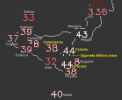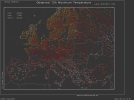"European heat record in Siracusa"
Updated 13 August 2021 • Published 13 August 2021 (SMHI)
During the
powerful heatwave known in Italy as "Lucifer" 
, Siracusa in Sicily reported a whopping 48.8° on Wednesday 11 August 2021. This is
if it is verified a new European heat record.
New heat records by the minute may cause some climate anxiety. [Buhuu,  hellooo Greeeta Land]
hellooo Greeeta Land] But in this case, from a purely statistical point of view, it is an opening. There has been a real mess in terms of heat records for Europe. According to the World Meteorological Organisation (WMO), the current record for Europe is 48.0° in Athens and Elefsina on 10 July 1977.
Global Weather and Climate Extremes
However, some independent assessors suggest that some high temperatures in Greece may have been influenced by forest fires. Instead, they point to another value from Sicily,
48.5° in Catenanuova*** on 10 August 1999. But that note, on the other hand, is not accepted by WMO.
[*** Note: Catania registered on the same day 44°C 10 Aug 1999, while Catenanuova a bit inland is known to be true hot spot, a bone dry place, often having excessive temperatures which I noticed can be 5°C higher during heatwaves compared with Catania when it goes over 40°C. Syracusa on the other hand, is a SEA port - and not a particular hot spot, and usually not diverting much from Catania's temperatures, which too, is a SEA port city]
The Spanish heat record, according to WMO, is 47.3° in Montoro on 13 July 2017. In the record compilation compiled by the Regional Climate Center for Europe, however, the Spanish weather service has given another record value on the same day.
Temperature record - Regional Climate Center
That's how it can go for other countries and continents too. The greatest confusion arises when it comes to the heat record for Africa. The WMO gives a value of 55° in Tunisia in 1931, while other assessors say there is no credible value in Africa higher than 51.3°.
Why this confusion?
It is obviously not good that the meteorological community cannot agree on what have been our highest recorded temperatures on earth. But how could it have come to this?
In the case of older measurements, it is a known problem that some stations may have been overexposed to direct or reflected solar radiation. Meteorologists of the time were probably aware of this. But it may not have been judged as accurate. After all, weather records are only for nerdy calendar biters (?). But in recent decades we have become increasingly aware that changes in weather extremes may be an important feature of climate change. It's a pity then that documentation hasn't always kept up. Here in Sweden, I think we are fortunate in this context to have a coherent organisation within SMHI for observations, forecasts, review and climate analysis.
Elsewhere, there may be more or less independent organisations responsible for different parts of the chain. In countries with a federal structure, there may also be parallel regional and national station networks, which does not make things any easier.
Exciting evaluation of the Siracusa record
The WMO will now evaluate the possible new European heat record in Siracusa. Unless it is already broken in the next few days in Spain. This kind of evaluation is usually very interesting to read. Not least because they give an insight into how different station networks and review procedures look like.
written by Sverker Hellström, SMHI




 hellooo Greeeta Land]
hellooo Greeeta Land]


